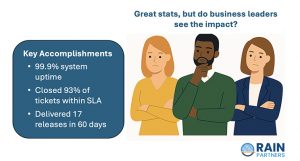Start Earning Your End-of-Year Bonus Now: How to Prepare Your Goals and Target Achievements

Last month we talked about how to increase your chances of receiving both your bonus and a sizable raise—even if you weren’t prepared for your negotiation. In sum, we offered a process that:
- Defined which of your past outcomes really mattered to the business.
- Detailed how you personally contributed to those outcomes.
- Demonstrated how you grew as an employee to make those contributions.
(If you missed the piece, read it here.)
While that process works, you don’t want to scramble every November to put together a last-minute case for increased compensation. That’s why we promised you a system for setting your Target Achievements well ahead of time, so—come year-end—you can arrive at your compensation conversation with a thick stack of leverage in hand.
Today, we’re going to outline that system.
It’s Not Just About the Money
Setting Target Achievements isn’t just about securing a bonus or a raise. While compensation matters, the afterglow of a bonus fades fast—and most IT professionals are driven by more than money. They crave impact, clarity, and contribution.
The Non-Financial Benefits of Target Achievements
A clear set of Target Achievements will help:
Individual Contributors
- Set measurable goals that align with performance expectations.
- Avoid investing time in projects that aren’t seen as valuable by the broader organization.
IT Leaders
- Evaluate team members systematically throughout the year.
- Build a rational project calendar that prevents resource, time, and staff conflicts.
Everyone
- Use a shared framework to track effort, manage risk, and align priorities.
- Shift the tone of stakeholder conversations from reactive to collaborative.
Even the least money-driven IT pro will gain from having Target Achievements in place.
How to Set Your Target Achievements
Before starting, note that this process assumes you have a direct manager and a formal year-end review. If you don’t, identify the person who influences compensation decisions and work with them.
1. Write Down Your Current Priorities
If no formal priorities were set at the end of last year, create the list yourself. Capture every key project or operational responsibility on your plate.
2. Define Your Contribution to Each Priority
Are you maintaining server uptime? Helping roll out new software? For each item, clarify your specific actions and expected outcomes.
3. Establish a Performance Baseline
Look at your historical performance for each area of responsibility. What were the metrics and outcomes? These form the baseline for improvement.
4. Set Improvement Targets
Identify how you’ll perform at a higher level this year. Raise each metric or outcome, even if only slightly. Your manager will likely help refine these targets later.
5. Add Timelines
Specify when you’ll deliver results. Outline milestone dates for both ongoing metrics and project-based contributions.
Now you have an Operating Plan—a document that clearly states what you’ll contribute, how you’ll measure success, and when it will be delivered.
6. Book a 1-Hour Meeting with Your Manager
Use the invitation to explain your intent: to review a set of defined targets and propose tying compensation to them.
7. Align on Targets
Your manager may accept your plan or adjust it. Either outcome is progress.
8. Link Compensation to Targets
If you already have a bonus structure, allocate percentages of the bonus to each target. If not, use this discussion to propose a raise or bonus contingent on hitting your agreed-upon outcomes. Get their commitment in writing.
9. Set Quarterly Review Meetings
Book 30-minute check-ins each quarter to review progress. These allow you to stay aligned, make course corrections, and reinforce accountability—on both sides.
A Final Word
For IT pros experienced in setting long-term goals, this framework will feel familiar. For others, it may seem overwhelming.
Here’s the secret: You don’t have to do it all today. Just take one small action at a time.
- Today, read this article—done.
- Tomorrow, draft your priority list.
- The next day, define your contributions.
Over the course of a week, you’ll build clarity, alignment, and influence—without burning out.
Ask yourself: “Am I willing to feel a little uncomfortable for one week to gain a full year of confidence and clarity?”
If your answer is yes, the rest will take care of itself.


